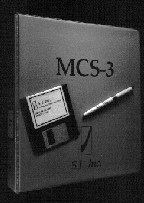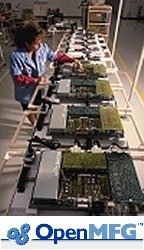
Flagge picture compliments of Solitude Mountain Resort, 1,200 acres of uncrowded Utah powder.
“the WORKS” is going to report on a topic this quarter that it often discussed
in the past, manufacturing software. During the years 1981 through 1998 manufacturing
and its control was the core of S. I. Inc. With the sale of MCS-3 the people of S. I. Inc.
moved into other disciplines. But Fate moves along curious paths and an opportunity has
returned us to manufacturing.
Believe it or not, there still are people using MCS-3. This is in spite of the fact that
there has not been support for the product in over a year and the people who bought MCS-3
from us have gone out of business. Needless to say, we know something about manufacturing
in general and MCS-3 in particular. With the addition of a new product from a third party,
S. I. Inc. finds itself back in its old stomping grounds.
If the S. I. Inc. relationship with manufacturing goes back to its founding in 1981, Robert
Schuldenfrei's association with production management goes back even further. He was introduced
to this discipline in 1965 and has never been far from it over these past 39 years. Bob first got
started with a consulting engagement with Ethan Allen Furniture and has done projects for
companies ranging from the Fortune 500 down to the smallest of job shops. While Hewlett
Packard, Nestle, and Armstrong Rubber represent some of the large firms, Comrex, Comfort
Pillow, and Leeman Labs represent the new opportunity. The largest of American enterprise have
pretty much obtained the gains from manufacturing control. It is the smaller firms, out of the
more than 350,000 manufacturers in the US, that stand to gain the most.
For the past six months Mr. Schuldenfrei has been on an extended consulting engagement to High
Tide Software of Newton, MA. The focus of this work has been business development for the firm.
As readers of the WORKS may remember, High Tide had made its mark in board-level embedded
software. Now it is moving into more business information technology. Of all of the things the
company could do, manufacturing software is the best direction for the firm at this time.
Shortly before starting with High Tide, OpenMFG, an independent software developer in Norfolk, VA,
contacted Bob to see if he would represent them in New England. Because his focus is solely on
consulting at this time, he declined the offer. However, after arraying the options for High Tide
Software, Bob became convinced that a match between these two companies would be beneficial
to both parties. After a bit of negotiation, High Tide Software became the New England representative
for OpenMFG.
To find out more about High Tide Software, please turn to
www.hightidesoftware.com . The web site for OpenMFG is
www.openmfg.com .
The OpenMFG product is fast, flexible and full-featured, with no competition in its price/performance category.
The system has a graphical user interface with open architecture that reduces time and cost in
implementation. The client side of the system can be Windows or LINUX. It can be configured to
conform to the specific needs of your installation whether you implement OpenMFG in its entirety
or in modular pieces. When you install OpenMFG you get the complete package. There are no
additional modules you need to buy. However you might identify a particular problem to be
addressed and begin with the implementation of an appropriate set of modules. As you see the
solution developing you will progress to solving another problem with a different module,
ultimately building to the comprehensive manufacturing control system provided by OpenMFG.
OpenMFG was designed to perform on a full spectrum of hardware from a single-user PC connected
to the OpenMFG server to large multi-user installations in which workstations can be positioned
at the most appropriate locations of your plant. It is in fact the same philosophy that S. I. Inc.
had when we owned MCS-3 except that it has a Windows look and feel.
The best part of finding OpenMFG at this point in time is that the opportunity for small manufactures
is still there. While almost all firms use a computer to do their basic accounting, few production
orientated firms use the computer to plan and control the production process. This means that they
are missing out on the cost savings aspect of computer based control systems. If you are not planning
production using Materials Requirements Planning (MRP), you are clearly spending too much on the
operations of your plant. The introduction of MRP has the potential to yield dramatic cost savings
for you. It does this by planning production so that the right materials are at the right place
at the right time. MRP can keep cash in the firm and still fulfill all production demands.
MRP solves problems in the future, not in the present or worse the recent past! Receiving a
forewarning of problems, while you still have time to do something about them, smoothes production and leads to steady,
lower cost operations. When this information is passed on to the execution systems of Purchase Order
Control and Shop Floor Control, you have the basis for a view of future needs to effectively reduce
the per unit price of the required materials. Thus your operations are pro-active rather than reactive.
In a future issue of the WORKS we plan to discuss OpenMFG in depth.
One of the nice things about the Microsoft database manager, Access, is that it is reasonably easy
to use. If you know anything about setting up a relational database system you will find Access
quick to set up and fairly easy for users to learn. One of the things that is not so nice is that
Access is attached to a "toy" database engine. It is fine for personal use, or perhaps a small work
group with a modest sized database, but for industrial strength applications Access does not cut it.
On the other hand, the nice thing about Microsoft SQL Server is that it is a powerful database system.
It can be used in the largest of enterprises on robust collections of data. It scales exceptionally well
such that it can be applied to information sources of monstrous proportions. One of the things that
is not so nice about SQL Server is that it really has no user friendly front end. Professional programmers
need to build custom user interfaces so that ordinary users can use the data.
What if you could design a system in Access, but use SQL Server as the database engine? Guess what... You can.
A little known fact about Access is with a little foresight, you can hook up the forms, queries, and reports
to SQL Server. The technique is called building a "Project" by Microsoft. There is considerable flexibility
on how this done. You could start from scratch and create an Access application and then migrate it to SQL.
Alternatively, you could take an existing SQL system and build an Access front end. Even more attractive is
taking an existing Access system that is straining to keep up with demands on it and give it new
life as a SQL application.
Regardless of the route Projects offer a nice growth path. They allow you to start small and grow into
applications. In this way you avoid the big commitment to a large, and potentially expensive,
computer based system. We have been doing a fair amount of work in Customer Relationship Management (CRM)
systems lately. An approach like this can take a sales rep's "black book" and in easy steps turn it
into a corporate wide CRM installation.
We have been devoting almost all of our available cycles to High Tide Software this past Fall. The good
people at High Tide have been working on a large project automating the driver testing system for the
Alaskan Department of Motor Vehicles. This involves the construction of test taking kiosks at 13 sites
around the state. Each group of kiosks at a test center is tied to an Examiner station. Each Examiner
machine is linked to a central Administration computer in Anchorage. The whole system is run as a
web service with every screen displaying web pages. The Applicant uses a touch screen in the test taking
kiosk. The tests and the results are shipped around the network through the use of SQL Server databases.
S. I. Inc. has been involved with that activity, the development of an OpenMFG capability, and the general
market development of software services for High Tide. We expect that the Winter of 2004 to continue in
much the same direction. S. I. Inc. will be fashioning plans to exploit the hierarchic control of
kiosks developed for the DMV. There are tremendous opportunities in self service for kiosk based systems.
Or send USPS mail to:
Return to Roots


Microsoft Access for Large Applications
S. I. Inc. this Past Fall
For additional information:
Phone: (781) 329-4828
S. I. Inc.
32 Ridley Road
Dedham, MA 02026